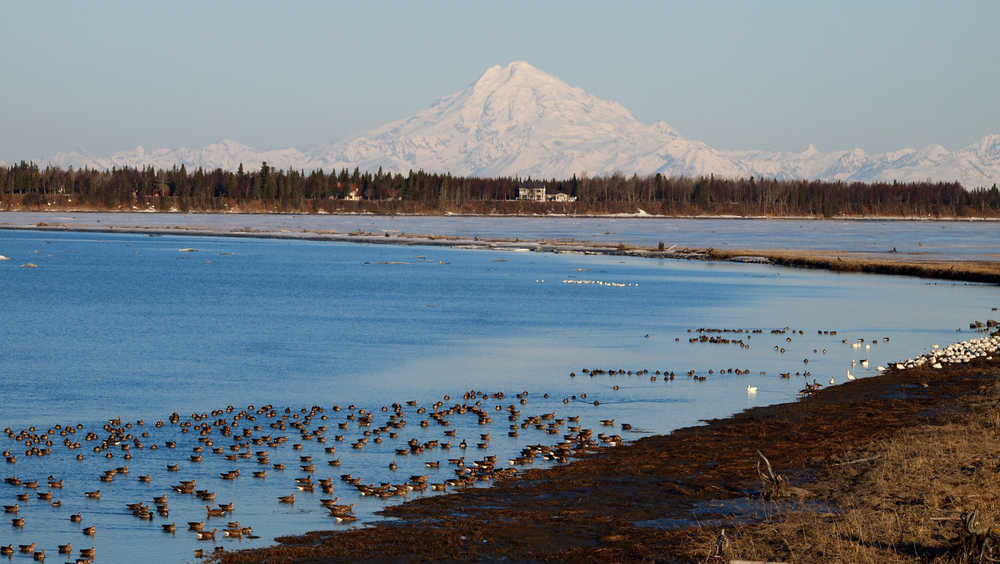Periodically, even through the cold of winter, I drive into Boat Launch Road at the Port of Kenai to use the wildlife viewing platform. It’s a convenient vantage point from which to search the Kenai Flats for signs of bird life.
At noon on March 22, at the tail-end of an incredibly mild winter and a series of warm, sunny afternoons, I climbed the viewing platform and was rewarded by finding five Northern Pintail ducks among the 50 or so exceptional Mallards that had overwintered there. Those five migrant ducks marked the end of my personal winter as they were true harbingers of spring, the long-awaited vanguard of spring migration.
What begins as a trickle soon becomes a torrent. Only five days later 300 gulls spiraled high over Cook Inlet and descended toward the mouth of the Kenai River. The next day 2,000 gulls occupied the colony across from the Port. Their numbers will be steadily augmented until the end of April when no less than 35,000 raucous gulls occupy that crowded piece of real estate.
In sharp contrast to last year’s record cold spring and delayed migration, this spring migration has commenced unusually early. The central Kenai Peninsula’s first spring migrants, Mallards, typically arrive the first week of April. Gulls are usually right behind, arriving about a week later. By mid-April, dabbling duck numbers are building rapidly and the first geese start to appear followed by Sandhill Cranes. At that time, Greater Yellowlegs are the first shorebirds to arrive with Black-bellied and Golden Plovers right behind them. In late April, raptors such as Osprey, Northern Harriers, Red-tailed and Rough-legged Hawks, Peregrine Falcons, and Golden Eagles typically appear in modest numbers.
By early May passerines, including most songbirds, begin to occupy area forests. The nuptial songs of American Robins, Varied Thrushes, Ruby-crowned Kinglets, and Dark-eyed Juncos are ubiquitous across our local landscape. Migrant diving ducks and Short-eared Owls also appear by this time as well as Trumpeter Swans awaiting ice-out on their nesting lakes.
By mid-May the floodgates of spring migration are wide open as loons, grebes, shorebirds, terns, and sparrows populate our area. In late May, warblers and swallows descend en mass, Swainson’s and Gray-cheeked Thrushes arrive, and our first flycatcher — the Western Wood-Peewee — lets us know that the last migrants are not far behind.
By the conclusion of the first week of June, all of our late arrivers such as Blackpoll and Yellow Warblers, and Olive-sided and Alder Flycatchers are finally here, on territory and in full song. Accordingly, by mid-June, area biologists are ready to begin their annual breeding bird surveys.
Spring migration in our area, from beginning to end, is approximately nine weeks in duration. Kenai National Wildlife Refuge trails provide some of the best venues to enjoy our area’s songbirds. Though these birds are more frequently heard then seen in their preferred wooded habitats, an early morning walk in June at the height of their nuptial song will not disappoint and can yield upwards of two dozen singing species. The Refuge’s Keen-Eye and Centennial Trails are not far from downtown Soldotna and are highly recommended for this purpose alone.
Tens of thousands of migrating ducks, geese, cranes, shorebirds, and gulls pass through the Kenai Flats from mid-April to mid-May. They can be viewed well from Sea Catch Drive, Bowpicker Lane, Bridge Access and Boat Launch Roads — each providing a front row seat. An unforgettable eagle’s eye view can be obtained from the bluff at the public parking lot at end of Spur View Drive near the Kenai Senior Center. If you haven’t yet witnessed the pandemonium of 50,000 birds vocalizing and flying in all directions when Bald Eagles disturb them from overhead, then you really need to get out more (to the Flats). It is a spectacle that must be experienced firsthand.
I encourage you to participate in the Kenai Birding Festival on May 15-18. Contact the Refuge, Kenai Watershed Forum, or the Keen Eye Birders for more information. Don’t let spring migration pass you by!
Toby Burke is a Biological Technician at the Kenai National Wildlife Refuge. For more information on the Refuge visit http://kenai.fws.gov or http://www.facebook.com/kenainationalwildliferefuge.

